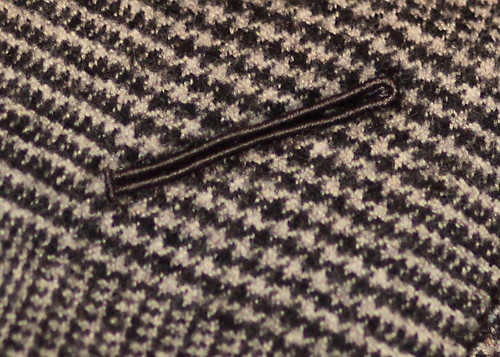
I think the Asolsa Lucida, or glossy buttonhole (the example above being from a Tom Ford garment), originated in the Abruzzi region of Italy as it is most commonly seen on garments made in this area. It is also very common in Paris, where it is known as the boutonnière Milanaise, though likely for the brand of gimp that was commonly used and not the city; it is worth noting that most of the grand tailoring houses of Paris also trace their lineage back to Italy. The gimp itself, which is a key element of the buttonhole, I believe is now only available from Guterman and is known as Agreman; I will be in Italy in June and will dig around to see if there are any other manufacturers still producing the stuff and will report back if I find any (and if anybody else will be at Pitti and feels like meeting up for a drink, drop me a line).
A while back, Matthew was kind enough to share a method he learned at Cifonelli for making these buttonholes, his with a purl underneath the gimp. The ones made by what I shall call the Abruzzi method, for want of a better term, do not have this purl under the gimp and the stitch is made differently- I will attempt to explain it now that I have figured it out.
In addition to the previously mentioned gimp (and do not be tempted to use what most other companies sell as gimp but is really intended for machine-made buttonholes) you will need some fine silk twist- to get a really smooth, glossy finish, a thread finer than the 40 size typically used now, and much finer than the U size that some still use, is needed, and unlike ordinary buttonholes, the twist should not be waxed.
Because this buttonholes is more fragile than the regular knotted one, it is typically only seen on the lapel, not on the lower buttonholes.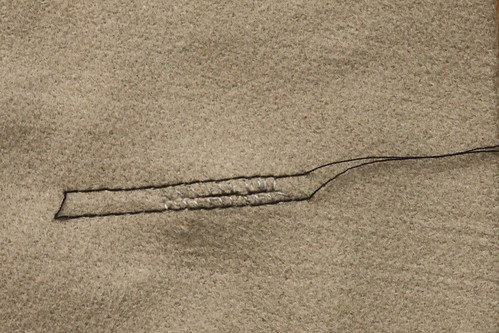
I start by running two rows of machine stitching to hold everything in place while I overcast the edges- it might also be a good idea to stitch even closer to the cut line than I have done and instead of ripping them after overcasting, just work the buttonhole over the stitching. A very narrow bite is required and this helps keep things from shifting, but also means that cloth that frays very easily is unsuitable.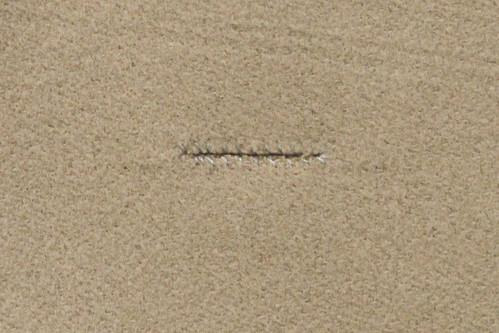
The mechanics of the stitch are actually quite simple but may take some getting used to if you have done lots of traditional buttonholes.
Working from the underside, pass the needle up through the hole- I find it easiest to poke the eye end through to avoid catching anything with the sharp end. I come up through the hole and then work the twist under the gimp, but for the sake of clarity I have shown the needle passing directly under the gimp. Do whatever is easiest for you.

Come up and over the gimp, then insert the needle a millimeter from the edge- tight, close stitching is the key to a smooth appearance. You want the gimp to sit right on top of the stitch to conceal it, and by tightly spacing the stitches you will completely encase the gimp.
I've pushed everything to one side so you can get an idea of how the stitches are forming.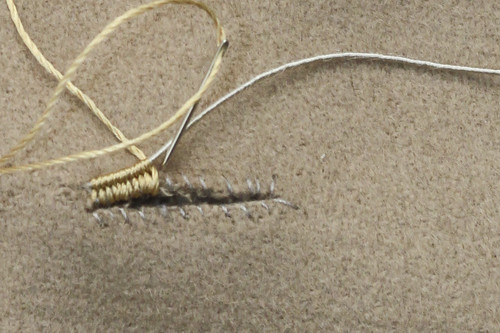
Pinch the gimp before working around the end of it the continue down the other side.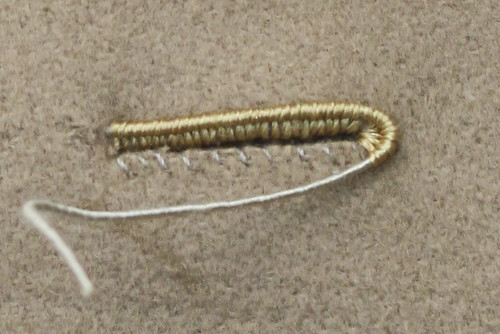
The completed buttonhole. You can see some of the stitches poking through beyond the gimp where my bite was a little too wide- I need to practice some more (and really have to think more seriously about a macro lens...)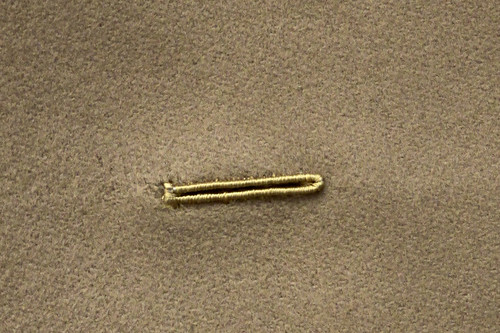
And thanks again to Matthew and Franca for inspiring this post.
EDIT- In response to a question, I made a few phone calls. In the U.S. Agreman gimp can be bought from B. Black and Sons (1-800-433-1546), Oshman Brothers (1-212-226-7448) and Ely Yawitz (1-800-325-7915) It is not listed on their websites so you have to call and ask for it.
In the U.K. it can be bought from Richard James Weldon 44 208 300 7878. I know there is at least one store in Paris which stocks it (ask for milanaise), though the name of it now escapes me. It is also available all over Italy (ask for vergolina).








25 comments:
following your thanks to matthew and franca, whom i would also like to thank for inspiring you, i'd like to thank you for showing us this. instructions on details like this are seldom found these days, and i am forever grateful to you for keeping this art alive.
That's miracolous, wonderful, fantastic. I am really fond of asole! Asola lucida is very interesting! Thanks to Matthey, Franca,Jeffrey!
Best regards,
an amateur Alessio
Jeffery,
Could you kindly post a shirt video of the Asola Lucida?
I am a newbie tailor and I dont really get the steps depicted (the cifonelli is clearer).
Thanks!!!
Hi Jeffery! What "s." said. I wholeheartedly concur! Glad to see you back! Missed 'ya.
I have asked around at a lot of stores and no-one has gimp. Where do you get yours?
@Steven- regular sewing stores won't stock it, only specialized tailor supply houses. I made a few calls to confirm that it was being sold by a number of places- the details are above.
@Jack- that kind of video requires a lot more spare time than I have these days- maybe during the summer shutdown...
great buttonhole Jeff. thanks for the post. How did you get on with the books?
Hello everyone, sono Franca,
I do not deserve any thanks because I have not done anything, but thanks go to Jeffery and Matthew who have given us all the opportunity to learn many things that were never spanked. In Italy many tailors are very jealous and not display their secrets, even if I call them the Pulcinella's secrets. Thanks, Jeffery really, thank you, and thank you very much for your wonderful blog.
oh, oh, Forgive my mistakes!!! Sorryyyyyy
The gimped in Italy you can buy in packages of 100 mt. Euro 3.26 in 7 colors:
BLACK, Verdon, BLUE, ECRU ', GRAY, BROWN AND RED, Raffaele Vitolo S.r.l. in Naples, incredible price, very cheap.
LINK:
http://www.vitolo.it/rv/index.php?cPath=1_107_10701212&art=7599&osCsid=977a337d4b215a6e1f5e4b22414b25f5#7599
@brendan- the techniques were a little dated, but interesting nonetheless- thank you.
@franca- wow- that is really cheap for the gimp! Thank you!
I just learned of this blog. I'm in heaven.
The shop in Paris is called "Lafayette Saltiel Drapiers". It's about 15EUR/100m if you buy the spool or I think something as crazy as 2EUR/m if bought per detail.
Never said it yet - now it's time:
Thanks, Jeffery, for this passionate and inspiring blog. If I may, I'd love to ask you a few questions...
Cheers
David
@David- thanks for reminding me of their name. But yikes- they are much more expensive than the Neapolitan source!
You can ask questions publicly in the comments section or privately via email- mine is up in my profile.
best,
J
How interestingly... How much time it need for making a buttonhole in this technology?
I don't have as much practice doing this kind of buttonhole so that will affect the time it takes; I do it find it much longer than the regular buttonhole because there are more stitches requires and the stitch formation itself is a little clumsy.
Have you any suggestions for doing handmade button holes on a heavier wool made of thick yarns? I am practicing buttonholes but am having a hard time with the fabric fraying in the cut area. Even with a machine stitch around the buttonhole area and an overcast stitch over the actual slit, the yarns still want to separate and fray. I love your blog, and any tips are appreciated. Thanks! - Liz
http://lizthayer.blogspot.com/
Liz- that kind of cloth is a beast. At a minimum, you should use a piece of silesia between the layers that will help stabilize, and maybe a little piece of non-woven fusible. Overcast carefully after cutting. Claire Shaeffer may have some tips- Chanel and YSL used that kind of cloth and did hand-worked buttonholes. She just revised her Couture book- I'll have a peek tonight.
Thank you! I'm determined to make nice buttonholes on this fussy fabric so I'm experimenting as I go. I just bought a clear non-fray liquid which I'm going to apply lightly before overcasting, sort of cheating but I'll try anything. Thanks for your suggestions, this is a great blog - love it!!!
Very Useful Post for the Beginners thanks for the post.i assumed your article as a good trainer.
I finished those button holes on my fussy fabric jacket. After about 15 practice rounds, I made them on the actual jacket and they turned out decent, though I can tell it takes years to really perfect this technique. Your posts on button holes were incredibly helpful - many thanks. Here's the jacket:
http://lizthayer.blogspot.com/2011/09/pendelton-wool-x-leather-jacket.html
Very nice description, love it! Thanks for revealing those secrets.
The Agreman gimp can also be had from The Lining Company here in the UK. RJW now apply a £5 surcharge for orders under £50 so if you just want to buy the gimp it is cheaper to get it through Lining Co.
I must say, this type of buttonhole is amazing. i'll definitely try it out in future.
So I managed pretty much master the technique (thanks to this blog) however i am a bit annoyed I can't find a way to finish the button hole at the end - in Tom Ford's suits where a neat vertical stitch seems to crosses over the entire button hole.I am not sure whether I should wrap it around a piece of gimp. The reason is, if I understood this button hole, the main button hole's gimp on each end get thread back underneath, therefore if I thread another piece of gimp (or the same piece going back up) the surrounding fabric will fray. Also what are the tips on securing the gimp? Do will simply knot it?
Tailoring said...
Very Useful blog thanks for the post.i assumed your article as a good trainer.
Post a Comment